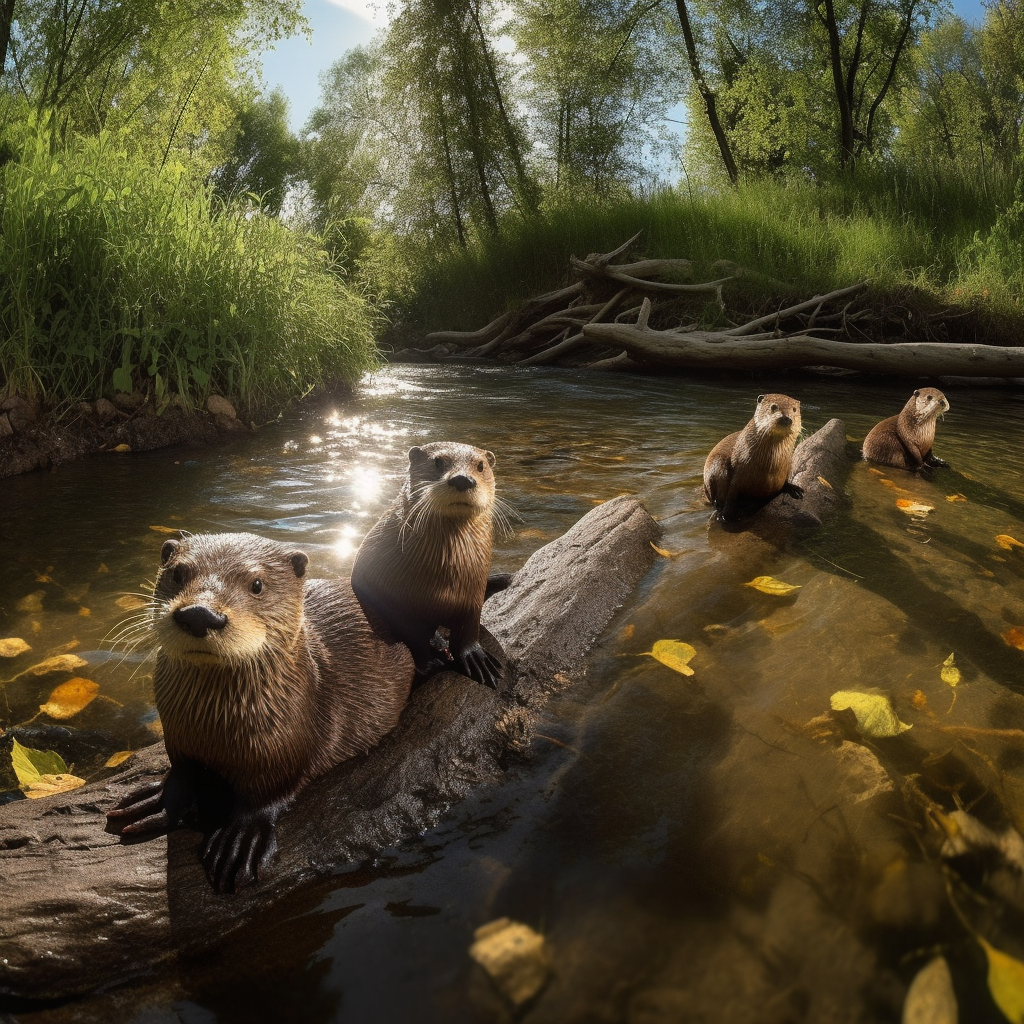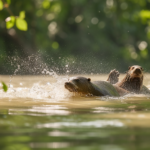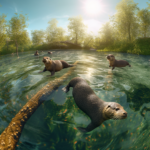River Otters Minnesota
River otters are fascinating creatures that can be found in various parts of the United States, including Minnesota. These playful and intelligent animals are well-adapted to their aquatic habitats and are known for their sleek bodies, webbed feet, and long tails. In Minnesota, river otters can be found in a variety of water bodies, including rivers, lakes, and wetlands. They are excellent swimmers and are often seen gliding effortlessly through the water, diving for fish, and playing with their otter companions. In this article, we will explore the world of river otters in Minnesota, their habitat, behavior, and conservation efforts to protect these charismatic creatures. So, let’s dive in and discover the wonders of river otters in Minnesota!
Key Takeaways
- River otters are native to Minnesota and can be found in various habitats such as lakes, rivers, and wetlands.
- They are excellent swimmers and have streamlined bodies, webbed feet, and a thick layer of fur that helps them stay warm in cold water.
- River otters play a crucial role in maintaining the balance of aquatic ecosystems by controlling populations of fish and invertebrates.
- They are social animals and often live in family groups called rafts.
- Conservation efforts have helped increase the population of river otters in Minnesota, but habitat loss and pollution remain significant threats to their survival.
The Fascinating World of River Otters in Minnesota
A. Understanding the River Otter: Size and Appearance
River otters are fascinating creatures that inhabit the freshwater ecosystems of Minnesota. These aquatic mammals are known for their playful nature and sleek appearance. Let’s take a closer look at the size and appearance of these captivating creatures.
Size
River otters are medium-sized mammals, with males typically being larger than females. On average, adult otters measure around 3 to 4 feet in length, including their tail. Their bodies are streamlined and elongated, allowing them to glide effortlessly through the water. Despite their size, river otters are surprisingly agile and can swim at speeds of up to 7 miles per hour!
Appearance
The North American river otter, found in Minnesota, has a dense, waterproof coat that keeps them warm in the water. Their fur is dark brown, with lighter shades on their chin and throat. This two-layered fur system helps to insulate them from the cold temperatures of their aquatic habitat. River otters also have webbed feet and a long, muscular tail, which they use as a rudder while swimming.
B. The North American River Otter in Minnesota
Minnesota is home to a thriving population of North American river otters. These playful creatures can be found in various habitats across the state, including rivers, lakes, and wetlands. Let’s explore their presence in Minnesota and the efforts made to protect their population.
River otters are well-adapted to the diverse ecosystems of Minnesota. They are excellent swimmers and are often spotted gliding effortlessly through the waterways of the state. The Minnesota Department of Natural Resources has been actively involved in monitoring and conserving the otter population. Through their efforts, the otter population has rebounded over the years, making it a success story for wildlife conservation in the state.
C. Are River Otters Dangerous?
River otters are generally not considered dangerous to humans. They are elusive creatures and tend to avoid human interaction. However, like any wild animal, they can become defensive if they feel threatened or cornered. It is important to respect their space and observe them from a safe distance.
While river otters are not typically aggressive towards humans, they are skilled hunters and can be territorial. They primarily feed on fish, amphibians, and crustaceans, and may occasionally scavenge on small mammals or birds. It’s best to admire these fascinating creatures from afar and avoid any actions that may disturb their natural behavior.
In conclusion, river otters in Minnesota are a captivating part of the state’s wildlife. Their size, appearance, and adaptability make them a remarkable species to observe in their natural habitat. With ongoing conservation efforts, the otter population in Minnesota continues to thrive, ensuring that future generations can also enjoy the wonders of these playful creatures.
The Habitat of River Otters in Minnesota

River otters are fascinating creatures that are native to North America. In Minnesota, these playful and charismatic mammals can be found in various habitats, but they are particularly well-suited to living near rivers. Let’s explore why otters choose this habitat, the importance of freshwater for their survival, the specific characteristics of the Minnesota River that make it a prime otter habitat, and the range of river otters in Minnesota.
A. Why Otters Live Near Rivers
River otters have adapted to life in and around rivers for several reasons. Firstly, rivers provide a reliable source of food for otters. These aquatic mammals primarily feed on fish, crayfish, frogs, and other small aquatic creatures. Rivers are teeming with such prey, making them an ideal hunting ground for otters.
Moreover, rivers offer otters a convenient means of transportation. Otters are excellent swimmers, and their streamlined bodies and webbed feet allow them to navigate through the water with ease. By living near rivers, otters can quickly move from one location to another in search of food or suitable habitats.
B. The Importance of Freshwater for Otters
Freshwater ecosystems are crucial for the survival of river otters. These ecosystems provide otters with the necessary resources, such as food and shelter, to thrive. Otters rely on clean and unpolluted water to support a healthy population of fish and other aquatic prey.
Additionally, freshwater habitats offer otters protection from predators. The dense vegetation along riverbanks provides cover and hiding spots, allowing otters to escape from potential threats. The availability of freshwater also ensures that otters have access to drinking water, which is essential for their survival.
C. The Minnesota River: A Prime Otter Habitat
The Minnesota River is a prime habitat for river otters in the state. This river stretches approximately 335 miles, flowing through central Minnesota and eventually joining the Mississippi River. The Minnesota River and its tributaries offer an abundance of resources that attract otters.
One of the key features of the Minnesota River that makes it an ideal otter habitat is its diverse range of fish species. The river supports a healthy population of fish, including walleye, northern pike, and catfish, which are all important food sources for otters. The availability of such prey ensures that otters have a consistent food supply.
The Minnesota River also provides otters with suitable denning sites. Otters construct their dens in riverbanks, using burrows or abandoned beaver lodges. The sandy soil along the Minnesota River‘s banks makes it easier for otters to dig these dens and create a safe haven for raising their young.
D. River Otter Range in Minnesota
River otters can be found in various regions of Minnesota, although their distribution is not uniform throughout the state. The Minnesota Department of Natural Resources has identified several areas where otters are commonly sighted, including the Minnesota River Valley, the St. Croix River, and the North Shore of Lake Superior.
These regions offer a combination of suitable habitat, abundant food sources, and adequate water quality, making them attractive to otters. Additionally, Minnesota’s numerous parks and protected areas provide additional opportunities for otters to thrive in a protected environment.
In conclusion, river otters in Minnesota have adapted to live near rivers due to the abundance of food and the convenience of transportation that rivers provide. Freshwater ecosystems, such as the Minnesota River, play a vital role in supporting otter populations by offering resources and protection. Understanding the habitat preferences and range of river otters in Minnesota is crucial for their conservation and ensuring their continued presence in the state’s diverse wildlife.
River Otters Beyond Minnesota

A. The Presence of River Otters in Alabama
While Minnesota is known for its thriving population of North American river otters, these fascinating creatures can also be found in other parts of the United States, including Alabama. Although river otters were once on the brink of extinction due to habitat loss and unregulated trapping, conservation efforts have led to their recovery in many states, including Alabama.
In Alabama, river otters can be found in various freshwater habitats such as rivers, lakes, and wetlands. They are well-adapted to aquatic life, with streamlined bodies, webbed feet, and a thick layer of insulating fur that keeps them warm in the water. These playful and social creatures are often seen swimming, diving, and playing in the water, making them a delight to observe in their natural habitat.
The presence of river otters in Alabama is not only a testament to the success of conservation efforts but also an indication of the health of the state’s freshwater ecosystems. River otters play a crucial role in maintaining the balance of these ecosystems by controlling populations of fish and other aquatic organisms. Their presence is a positive sign for the overall health and biodiversity of Alabama’s rivers and wetlands.
B. River Otters in Colorado: A Comparative Study
Colorado, with its diverse landscapes and abundant waterways, is another state where river otters can be found. Similar to their counterparts in Minnesota and Alabama, river otters in Colorado inhabit rivers, lakes, and marshes. However, studying the river otters in Colorado provides an opportunity for comparative research and understanding the adaptations and behavior of these fascinating creatures in different environments.
One notable difference between river otters in Minnesota and Colorado is their habitat preference. While Minnesota is known for its numerous rivers, lakes, and wetlands, Colorado’s river otters are more commonly found in high-altitude streams and mountain lakes. This difference in habitat reflects the adaptability of river otters to various environments and their ability to thrive in different ecosystems.
Researchers in Colorado have been studying river otters to gain insights into their behavior, diet, and population dynamics. By comparing the findings from different regions, scientists can better understand the factors that influence river otter populations and their ecological role in freshwater ecosystems. These studies contribute to the broader understanding of river otters’ conservation needs and help inform management strategies for their protection.
C. Are there River Otters in Iowa?
While river otters are known to inhabit many states across the United States, including Minnesota, Alabama, and Colorado, their presence in Iowa is less certain. Historically, river otters were extirpated from Iowa due to habitat loss and unregulated trapping. However, efforts have been made to reintroduce river otters to the state in recent years.
In the early 1980s, the Iowa Department of Natural Resources initiated a reintroduction program to bring river otters back to the state. The program involved releasing otters into suitable habitats and monitoring their population growth and distribution. Over the years, these efforts have shown promising results, with river otters making a comeback in certain areas of Iowa.
Today, river otters can be found in select regions of Iowa, particularly along major rivers and their tributaries. These areas provide the necessary habitat and food sources for river otters to thrive. While their population in Iowa is still relatively small compared to other states, the presence of river otters is a positive sign of the state’s commitment to wildlife conservation and the restoration of natural ecosystems.
In conclusion, river otters are not limited to Minnesota but can be found in various states across the United States, including Alabama, Colorado, and even Iowa. Their presence in these states highlights the importance of conservation efforts and the resilience of these remarkable creatures. By studying river otters in different regions, scientists can gain valuable insights into their behavior, adaptations, and the overall health of freshwater ecosystems.
The Diet of Minnesota River Otters
A. What Do Minnesota River Otters Eat?
Minnesota river otters have a diverse diet that consists mainly of fish, but they are opportunistic feeders and will consume a variety of other prey as well. Fish make up the majority of their diet, with species such as perch, catfish, and sunfish being common targets. These otters are skilled hunters and have adapted to their aquatic lifestyle with specialized physical features that aid in catching fish.
In addition to fish, Minnesota river otters also feed on crustaceans, amphibians, reptiles, and small mammals. Crayfish, frogs, turtles, and muskrats are among the other prey items that otters will consume. They have sharp teeth and strong jaws that allow them to capture and consume a wide range of prey.
To catch their food, river otters use their keen sense of smell and excellent underwater vision. They are agile swimmers and can dive to depths of up to 60 feet in search of prey. Otters are known to be voracious eaters, consuming around 15% to 20% of their body weight in food each day.
B. The Role of Diet in Otter Habitat Selection
The diet of Minnesota river otters plays a crucial role in their habitat selection. These otters are highly dependent on freshwater ecosystems, such as rivers, lakes, and wetlands, which provide them with an abundant supply of food. They are particularly attracted to areas with a high density of fish and other prey species.
The availability of suitable prey is a key factor that determines the presence of river otters in a particular habitat. Otters are known to be selective in their habitat choices, preferring areas with diverse fish populations and ample vegetation cover. They are also more likely to inhabit areas with clean water and minimal human disturbance.
The diet of river otters is closely linked to the overall health of the ecosystem they inhabit. As top predators, they help maintain a balance in the aquatic food chain by controlling the populations of their prey species. Their presence in an ecosystem indicates a healthy and thriving environment.
In conclusion, the diet of Minnesota river otters consists primarily of fish, but they are adaptable and will consume a variety of other prey as well. Their diet plays a crucial role in their habitat selection, with a preference for areas with abundant fish populations and minimal human disturbance. By understanding the diet and habitat requirements of these fascinating creatures, we can better appreciate and protect their natural environment.
The Conservation Status of River Otters
A. Why Otters are Endangered
River otters, native to Minnesota, are facing significant challenges that have led to their endangered status. Several factors contribute to the decline in otter populations, including habitat loss, pollution, and overhunting.
Habitat Loss: The destruction of wetlands and the alteration of river ecosystems have had a detrimental impact on otter populations. These semi-aquatic mammals rely on clean and undisturbed freshwater habitats for their survival. As human activities continue to encroach upon their natural habitats, otters are left with limited resources and suitable areas to thrive.
Pollution: Pollution, particularly water pollution, poses a significant threat to river otters. Chemical contaminants, such as pesticides and industrial waste, can accumulate in their prey and ultimately affect the otters themselves. Additionally, pollution can degrade the water quality, making it unsuitable for otters to hunt and live in.
Overhunting: Historically, river otters were heavily hunted for their fur, which was highly valued in the fur trade industry. This unregulated hunting led to a severe decline in otter populations across North America, including Minnesota. Although hunting regulations have been implemented to protect otters, illegal trapping still occurs, further endangering their survival.
B. Trapping River Otters in Minnesota: Legal and Conservation Aspects
Trapping river otters in Minnesota is a complex issue that involves balancing the interests of conservation and human activities. The Minnesota Department of Natural Resources (DNR) regulates otter trapping to ensure the sustainability of the population while considering the needs of trappers.
The DNR sets specific trapping seasons and limits to control the harvest of otters. Trappers must obtain a valid license and adhere to strict regulations, including using specific trap types and reporting their harvest. These measures aim to prevent overexploitation and maintain a healthy otter population.
Conservation efforts also focus on educating trappers about responsible trapping practices. Trappers are encouraged to release non-target species and to avoid trapping otters during the breeding season. By promoting ethical trapping methods, the DNR aims to minimize the impact on otter populations while still allowing for sustainable trapping activities.
C. River Otter Season in Minnesota: A Controversial Topic
The river otter season in Minnesota is a subject of debate among various stakeholders, including conservationists, trappers, and wildlife enthusiasts. The controversy stems from differing perspectives on the impact of trapping on otter populations and the ethical considerations surrounding the practice.
Proponents of the otter trapping season argue that it provides economic opportunities for trappers and contributes to wildlife management. They believe that regulated trapping can help control otter populations and prevent overpopulation, which could lead to negative ecological consequences.
On the other hand, opponents express concerns about the potential harm caused by trapping. They argue that trapping can disrupt otter social structures, lead to the accidental capture of non-target species, and contribute to stress and injury among trapped animals. Additionally, some argue that the economic benefits of trapping may not outweigh the potential harm to otter populations and their ecosystems.
The controversy surrounding the river otter season in Minnesota highlights the need for ongoing dialogue and collaboration between stakeholders. Balancing the interests of conservation, economic opportunities, and ethical considerations is crucial for ensuring the long-term survival and well-being of river otters in the state.
The Human-Otter Interaction

A. How to Adopt a River Otter: Ethical Considerations
Adopting a river otter as a pet may seem like an appealing idea to some, but it’s important to consider the ethical implications before making such a decision. River otters are wild animals that have specific needs and behaviors that may not be suitable for domestication.
Here are a few ethical considerations to keep in mind:
-
Legalities: Before even considering adopting a river otter, it’s crucial to research and understand the laws and regulations surrounding wildlife ownership in your area. In many places, it is illegal to keep a river otter as a pet without the proper permits and licenses.
-
Natural habitat: River otters are highly adapted to their natural habitat, which includes rivers, lakes, and wetlands. They are excellent swimmers and require ample space to roam and explore. It would be challenging, if not impossible, to provide them with the same level of freedom and stimulation in a domestic setting.
-
Social needs: River otters are social animals that live in family groups. They engage in playful behaviors, communicate with each other, and rely on their social bonds for survival. Keeping a river otter as a solitary pet would deprive them of their natural social interactions and could lead to loneliness and behavioral issues.
-
Specialized care: River otters have specific dietary and environmental requirements that may be difficult to meet in a home setting. They require a varied diet consisting of fish, crustaceans, and small mammals, which can be expensive and time-consuming to provide. Additionally, they need access to clean water for swimming and grooming.
In light of these considerations, it is generally recommended to appreciate river otters in their natural habitat rather than attempting to adopt them as pets. Instead, consider supporting local wildlife conservation efforts or visiting wildlife sanctuaries where you can observe these fascinating creatures in a responsible and ethical manner.
B. How to Attract River Otters: A Guide for Wildlife Enthusiasts
If you’re a wildlife enthusiast and want to catch a glimpse of river otters in their natural habitat, there are a few steps you can take to increase your chances of spotting these elusive creatures. Remember, patience and respect for their environment are key.
Here are some tips to attract river otters:
-
Research their habitat: River otters are most commonly found near freshwater ecosystems such as rivers, lakes, and wetlands. Research the specific areas in Minnesota where river otters are known to inhabit, such as the Mississippi River, Minnesota River, or the Boundary Waters Canoe Area Wilderness.
-
Timing is everything: River otters are most active during early morning and late afternoon. Plan your visit to their habitat accordingly, and be prepared to spend several hours observing and waiting for their appearance.
-
Quiet and stillness: River otters are sensitive to noise and movement. When you’re near their habitat, try to minimize any disturbances. Avoid sudden movements, keep your voice low, and use binoculars or a camera with a telephoto lens to observe them from a distance.
-
Look for signs: River otters leave behind signs of their presence, such as tracks, slides, and scat. Learn to identify these signs, as they can indicate recent otter activity in the area. Look for slides along riverbanks, which are smooth, muddy areas where otters enter and exit the water.
-
Bring the right equipment: To enhance your chances of spotting river otters, bring a pair of binoculars or a spotting scope to help you observe them from a distance. A camera with a telephoto lens can also allow you to capture their behavior without disturbing them.
Remember, when observing river otters, it’s important to maintain a respectful distance and avoid any actions that could disrupt their natural behavior. Enjoy the experience of witnessing these fascinating creatures in their natural habitat, and take the opportunity to learn more about their behavior and ecology.
C. Otter Tail Minnesota Restaurants: A Unique Connection
Otter Tail County in Minnesota is not only known for its beautiful lakes and outdoor recreational opportunities but also for its unique connection to river otters. Several local restaurants in the area have embraced the otter theme, adding a touch of charm and whimsy to the dining experience.
Here are a few otter-themed restaurants in Otter Tail County:
| Restaurant Name | Location | Otter-Inspired Dish | |———————|——————-|———————————————–| | Otter Supper Club | Battle Lake | Otter Tails (Battered and Fried Walleye) | | Otter Coffee House | Fergus Falls | Otter Latte (Caramel and Hazelnut Flavored) | | Ottertail Burger Co. | Ottertail | Otter Burger (Juicy Bison Patty with Toppings)| | Otter Express | Perham | Otter Poutine (Crispy Fries with Cheese Curds)|
These restaurants not only offer delicious food but also provide a unique dining experience that celebrates the local wildlife. The otter-themed dishes and decor add a playful touch to the ambiance, making them popular among locals and visitors alike.
When visiting Otter Tail County, be sure to check out these otter-inspired restaurants and indulge in their specialty dishes. It’s a wonderful way to connect with the local culture and appreciate the beauty of Minnesota’s wildlife in a fun and delicious way. Conclusion
In conclusion, river otters in Minnesota are fascinating creatures that play a vital role in the state’s ecosystems. With their playful nature, sleek bodies, and excellent swimming abilities, they are well-adapted to their aquatic habitats. River otters are known for their strong family bonds and cooperative hunting techniques. They primarily feed on fish, crustaceans, and amphibians, contributing to the balance of the food chain. Despite facing challenges in the past, such as habitat loss and pollution, conservation efforts have helped their populations rebound. Today, river otters can be found in various water bodies across Minnesota, bringing joy to nature enthusiasts and serving as indicators of a healthy environment. As we continue to protect and preserve their habitats, we ensure the survival and well-being of these charismatic creatures for generations to come.
Frequently Asked Questions
1. What is the river otter habitat in Minnesota?
River otters in Minnesota typically inhabit freshwater ecosystems, including rivers, lakes, and wetlands. They prefer habitats with abundant food sources and nearby cover for hiding and resting. The Minnesota Department of Natural Resources works to protect these habitats to ensure the survival of the otter population.
2. How big are river otters in Minnesota?
The size of river otters in Minnesota typically ranges from 3.5 to 5 feet in length, including the tail. They can weigh between 10 and 30 pounds, with males generally being larger than females.
3. Are there river otters in Alabama?
Yes, river otters are found in Alabama. They inhabit various freshwater habitats across the state, including rivers, lakes, and marshes.
4. Are there river otters in Colorado?
Yes, river otters are also found in Colorado. They were reintroduced into the state in the 1980s and have since established a stable population.
5. Why are otters endangered?
Otters are endangered due to a variety of factors, including habitat loss, pollution, and illegal hunting. Efforts are being made by conservation organizations and government agencies to protect otter habitats and regulate hunting.
6. Why do otters live near rivers?
Otters live near rivers because they are semi-aquatic mammals that rely on water for their diet, which mainly consists of fish, amphibians, and crustaceans. Rivers also provide otters with a means of quick escape from predators.
7. What do Minnesota river otters eat?
Minnesota river otters primarily eat fish, but their diet also includes amphibians, crayfish, and occasionally small mammals and birds.
8. How can I adopt a river otter?
Adopting a river otter is not possible as they are wild animals. However, many conservation organizations offer symbolic adoptions where your donation goes towards the protection and conservation of these animals.
9. Are river otters dangerous?
While river otters are generally not dangerous to humans, they are wild animals and can become aggressive if they feel threatened or cornered. It’s always best to observe them from a distance.
10. How can I attract river otters to my property?
Attracting river otters to your property can be challenging as they are elusive and wary of humans. However, maintaining a healthy aquatic ecosystem, with plenty of fish and clean water, might make your property more appealing to them. Always remember that otters are protected by law and should not be disturbed or harassed.




